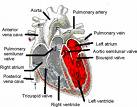systemic circulation
By bellovedsagi
@bellovedsagi (1)
5 responses
@thisisme (263)
• United States
11 Oct 06
group of organs that transport blood and the substances it carries to and from all parts of the body. The circulatory system can be considered as composed of two parts: the systemic circulation, which serves the body as a whole except for the lungs, and the pulmonary circulation, which carries the blood to and from the lungs. The organs of circulatory system consist of vessels that carry the blood and a muscular pump, the heart, that drives the blood.
if you need more in depth info....
In the systemic circulation, which serves the body except for the lungs, oxygenated blood from the lungs returns to the heart from two pairs of pulmonary veins, a pair from each lung. It enters the left atrium, which contracts when filled, sending blood into the left ventricle (a large percentage of blood also enters the ventricle passively, without atrial contraction). The bicuspid, or mitral, valve controls blood flow into the ventricle. Contraction of the powerful ventricle forces the blood under great pressure into the aortic arch and on into the aorta. The coronary arteries stem from the aortic root and nourish the heart muscle itself. Three major arteries originate from the aortic arch, supplying blood to the head, neck, and arms. The other major arteries originating from the aorta are the renal arteries, which supply the kidneys; the celiac axis and superior and inferior mesenteric arteries, which supply the intestines, spleen, and liver; and the iliac arteries, which branch out to the lower trunk and become the femoral and popliteal arteries of the thighs and legs, respectively. The arterial walls are partially composed of fibromuscular tissue, which help to regulate blood pressure and flow. In addition, a system of shunts allows blood to bypass the capillary beds and helps to regulate body temperature.
2 people like this
@geevee (884)
• India
27 Nov 06
In the systemic circulation, which serves the body except for the lungs, oxygenated blood from the lungs returns to the heart from two pairs of pulmonary veins, a pair from each lung. It enters the left atrium, which contracts when filled, sending blood into the left ventricle (a large percentage of blood also enters the ventricle passively, without atrial contraction). The bicuspid, or mitral, valve controls blood flow into the ventricle. Contraction of the powerful ventricle forces the blood under great pressure into the aortic arch and on into the aorta. The coronary arteries stem from the aortic root and nourish the heart muscle itself. Three major arteries originate from the aortic arch, supplying blood to the head, neck, and arms. The other major arteries originating from the aorta are the renal arteries, which supply the kidneys; the celiac axis and superior and inferior mesenteric arteries, which supply the intestines, spleen, and liver; and the iliac arteries, which branch out to the lower trunk and become the femoral and popliteal arteries of the thighs and legs, respectively. The arterial walls are partially composed of fibromuscular tissue, which help to regulate blood pressure and flow. In addition, a system of shunts allows blood to bypass the capillary beds and helps to regulate body temperature.
@mythmoh (3984)
• United States
11 Oct 06
The left ventricle pumps oxygen rich blood from the lung through the arteries to all organs of the body. In order that every single cell is supplied with the vital oxygen and all nutrients, the major arteries ramify into increasingly smaller arteries. These branch again into even smaller arteries, called arterioles, and finally into capillaries, a dense network of tiny vessels. From these capillaries oxygen exchange takes place with the cells. The capillaries then transit into the venules, the smallest veins. The venules transport the now oxygen-poor, carbon dioxide-rich blood away from the cells until ultimately the "used" blood reaches the right ventricle through the vena cava. The blood is now pumped back to the lung.
1 person likes this
@DoctorDidi (7018)
• India
18 Jul 12
There are two types of circulation of blood in the body- Systemic and pulmonary. The systemic circulation of blood comprises that circulation of blood which is between the heart and the other organs excepting the lung. The pulmonary circulation of blood comprises that circulation of blood which is between the heart and the lung.









